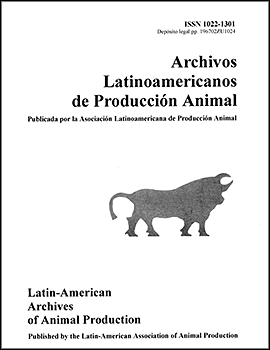
|
Archivos Latinoamericanos de Produccion Animal
Asociacion Latinoamericana de Produccion Animal
ISSN: 1022-1301
EISSN: 1022-1301
Vol. 14, No. 2, 2006, pp. 33-41
|
 Bioline Code: la06005
Bioline Code: la06005
Full paper language: English
Document type: Research Article
Document available free of charge
|
|
|
Archivos Latinoamericanos de Produccion Animal, Vol. 14, No. 2, 2006, pp. 33-41
| es |
Aceitação de larvas de diferentes grupos genéticos de Apis mellifera  na produção de abelhas rainhas na produção de abelhas rainhas
V.N. Albarracín, S.R. Cunha Funari, E.M. Romero Arauco, R. de Oliveira Orsi
Resumen
A colônia de abelhas Apis mellifera

se perpetua por meio de sua contínua renovação, onde a rainha desempenha um papel de suma importância na sobrevivência da colônia e continuidade da espécie, determinando as características e a produtividade dessa colmeia. A rainha é alimentada, durante as fases larval e adulta, com geleia real secretada pelas glândulas hipofaringeanas e mandibulares das operárias nutrizes. O objetivo deste trabalho foi avaliar a porcentagem de aceitação de larvas nos diferentes grupos genéticos de abelhas Apis mellifera (italiana e africanizada), na produção de rainhas. O experimento foi desenvolvido no Setor de Apicultura, Facultade de Medicina Veterinaria e Zootecnia, UNESP, Campus de Botucatu, SP, Brasil. Foram estudados 7 colmeias do grupo genético africando e 7 colmeias do grupo genético italiano, distrubuidas em três tratamentos: T1 (larvas do mesmo grupo genético e matrilínea,). T2 (larvas do mesmo grupo genético e diferente matrílinea) e T3 (larvas de diferente grupo genético), sendo que as realeiras estavam posicionadas em três locais da barra do quadro porta realeiras: A (anterior, na parte mais próxima do alvado), M (centro) e F(na parte mais distante do alvado). Conclui-se que na produção de rainhas, os grupos genéticos e os tratamentos não apresentaram diferenças significativas na porcentagem de aceitação de larvas e na produção da geleia real por realeira; quanto aos locais, não houve diferença significativa para a porcentagem de aceitação de larvas, mas quanto ao peso da geleia real, o local M apresentou melhor produção que os locais A e F; e quanto maior foi a porcentagem de aceitação de larvas, maior foi o peso da geleia real e maior o peso da larva, para ambos grupos genéticos.
Palabras-clave
Apis mellifera, rainhas, produção de rainhas, larvas
|
| |
| en |
Acceptance of larvae from different genetic groups of Apis mellifera  in queen bee production in queen bee production
V.N. Albarracín, S.R. Cunha Funari, E.M. Romero Arauco, R. de Oliveira Orsi
Abstract
Honeybee renewal depends on the reproductive process, in which the queen plays a dominant role, thus fostering beehive survival and maintenance of hive characteristics and productivity. Royal jelly, secreted by the hypopharyngeal and mandibular glands of worker honeybees, constitutes the queen's diet, both in the larval stage and the adult. The goal of this study was to evaluate the percentage acceptance of larvae, of different genetic groups of Apis mellifera

, in the production of queens. The work was carried out at the Beekeeping Section, FMVZ, UNESP, Campus de Botucatu Sp Brasil. Three treatments were included: T1 (larvae from the same genetic group and the same colony), T2 (same genetic group and different colony), and T3 (different genetic groups). The two genetic groups used were Africanized and Italian. Queen cells were placed in three different bar positions: A (in front, close to the entrance), M (in the middle), and F (at the rear, far from the entrance). In the process of queen production, the genetic groups and treatments showed no significant differences in percentage acceptance of larvae and weight of royal jelly for queen cells. Bar positions had no significant effect on the acceptance percentage of larvae, but the M position resulted in greater weight of royal jelly for queen cells than positions A and F. Greater percentage of larvae acceptance was associated with greater weight of royal jelly for queen cells and greater weight of larvae produced, in both genetic groups.
Keywords
Apis mellifera, queen production, larvae
|
| |
© Copyright 2006 - ALPA. Arch. Latinoam. Prod. Anim.
Alternative site location: http://www.alpa.org.ve/ojs/index.php
|
|
